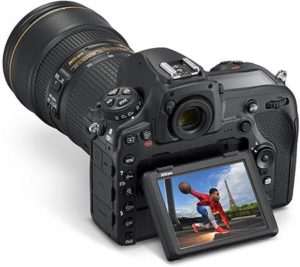NikonD850 vs Nikon D750
When comparing just the specifications for the NikonD850 vs Nikon D750, the D850 is the clear winner. The D850 has a considerable edge in almost every aspect – be it the pixel count or video resolution. These features come at a higher price, and for a photographer or filmmaker – the biggest question is if the higher price is justified.
For Still Photographers
When comparing the Nikon D750 vs Nikon D850, it’s not a straight-forward megapixel war. Although D850 offers 46MP, as opposed to D750’s 24MP, the sensor and processor of the D850 are more impressive. For general purposes, a 24MP camera is perfect to print even billboard-size pictures. The D750 offers a full-frame CMOS Sensor, while the D850 offers BSI-CMOS Sensor. BSI stands for back-illuminated sensor, which involves the circuitry of the sensor behind it. This improves low-light performance and creates images with less noise.
The other major advancement is EXPEED 5 processor of D850 against EXPEED 4 processor of D750 – considerably faster, and improves low-light performance. Without an anti-aliasing filter, the D850 outputs considerably sharper images. On the other hand, the Nikon D750 has a built-in flash (so does the D810, the D850 predecessor) – though most professional photographers would rarely use this feature for anything but triggering off-camera speed lights.
For Filmmakers – Is 4K Video Worth it?
Nikon D850 is the first Nikon DSLR to offer 4K video. The video resolution of 3840 x 2160 is exactly double that of Nikon D750: 1920 x 1080 (Full HD). One benefit of shooting 4k video with the Nikon D850 is the full-frame (not-cropped) use of the sensor. This means the focal length of the lens remains the same, with no crop factor, unlike the D750’s 1.5x magnification on all lenses. The Nikon D850 can record 4K videos at 24, 25, or 30 fps.
Nikon D850 is also better for slo-mo. It can shoot full HD footage at 60fps and 120fps. The D750 can record full HD video up to 60fps. The in-built time-lapse video feature can record 4k and 8k time-lapse sequences in the D850. D750 can record time-lapse video of up to Full HD in-camera.
Shooting 4k video has some benefits, but it’s large file sizes can make it difficult to work with.
Final Thoughts – Nikon D750 vs Nikon D850
The Nikon D850 has the clear edge when it comes to specifications. However, there’s the price difference is significant. For filmmakers and still photographers, if you can afford it, the Nikon D850 is a purchase you won’t regret. However, for filmmakers on a budget, the D750 is a very capable camera. Even with 2018 just around the corner, 4K video isn’t the standard yet – and for most projects, probably won’t be for some time.
For more on 4k video and your business, check out: The Business Implications of 4k video
MSRP and Sale Prices – Nikon D850 and D750:
Nikon D750 Price – Body Only: $1,999 (View Sale Price)
Nikon D750 w/ 24-120mm Lens: $3,099 (View Sale Price)
Nikon D850 Price – Body Only: $3,299 (View Sale Price)
w/ 105mm Lens: $5,499 (View Sale Price)
w/ 200-500mm Lens: $4,699 (View Sale Price)
w/ 24-120mm Lens: $4,399 (View Sale Price)
w/ 24-70mm Lens: $5,699 (View Sale Price) (Recommended configuration*)
w/ 28mm Lens: $5,295 (View Sale Price)
w/ 8-15mm Lens: $4,549 (View Sale Price)
*We’re big fans of the Nikon 24-70 for video and photography – read more in the article, The Five Best Lenses for Nikon Videography. Or, TL:DR – It’s a high quality lens with a versatile zoom length and low (fast) aperture perfect for all kinds of video shooting.
 Nikon DSLR Video Videography News, Tutorials, Reviews, and Information
Nikon DSLR Video Videography News, Tutorials, Reviews, and Information
